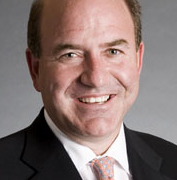William Paiva selected executive director of OSU's Center for Health Systems Innovation
Monday, February 3, 2014

William Paiva was recently named the new executive director of Oklahoma State University’s Center for Health Systems Innovation (CHSI). Paiva, a health and biotech venture capitalist who has served as a board of director for the CHSI since its establishment in 2012, proves that he’s more than qualified for the position with his numerous abilities.
Paiva, an Oklahoma native, moved East while attending business school and then worked in investment banking and in the pharmaceutical industry before returning to Oklahoma in 2000 to enter the venture capital industry. For the past 14 years he has been investing in cutting edge health care companies through Sevin Rosen Funds, Chisholm Private Capital and the Oklahoma Life Science Fund. In addition, he’s also taught venture capital courses and entrepreneurship classes at OSU’s Spears School of Business, Tulsa University and the University of Oklahoma
He brings more than 25 years of venture-capital, biomedical-industry and management-consulting experience to the CHSI. He specializes in identifying early-stage venture opportunities at the intersection of traditional information technology sectors and health care.
Paiva views the opportunity to lead the Center as a great opportunity at a great time. He thinks that regardless of a person’s perception of Obama Care and the Affordable Health Care Act politically, something has to and will change in the United States health care system
“Because of Obama Care and the Affordable Health Care Act, pressures to achieve our current standard of health care quality while containing costs, and the gap between the demand on our health care system and the supply of health care providers, the reality is the way health care is going to be delivered is going to change,” Paiva said
“If you’re a health care consumer, then it causes you some anxiety because change causes anxiety. If you’re an innovator, academic or an investor then it’s a great time in our U.S. health care system because change is good and creates opportunities for innovators. Change enables new models, new opportunities and new innovation,” he added.
Paiva describes his new role as the Executive Director of the Center as a couple-fold. One part is defining CHSI’s strategy, getting buy-in from the stakeholders and then executing the strategy to achieve measurable results. The second part is drawing the connectivity for the Center to local, national and international organizations to further drive CHSI’s strategy and position in the evolving U.S. health care system.
He believes that the gauge for success for the Center is defining a strategy and making sure it’s executed. “We will also make sure we are focusing on programs, projects and initiatives that have measurable outcomes and definable and tangible results.”
“We’re fortunate because of the support of Neal Patterson to provide CHSI with a generous gift that allows us to executive some exciting initiatives. In addition, we have had the benefit of the initial foundation put in place by the staff at Oklahoma State University,” Paiva said.
“What, in my opinion, will allow us to judge success in five years is that when we look back, did we actually move the needle? Did these programs and initiatives have a relevant impact to Oklahoma’s and the United States’ health care system? And were we able to deliver new innovative products, models and thought leadership and research for our evolving health care system?”
He explains that the strategy is composed of four key parts. First, they will review the Center’s digital or electronic medical record database to gain meaningful insight. Second, they will leverage the great work already being conducted in OSU’s unique large rural health care market and look for new, innovative products and services that can deliver through the rural channel. Third, the area of thought leadership around the U.S. health care delivery model is changing, so they need to bring in key thoughts, insights and opinions. Lastly, they need to determine how to support the existing undergraduate and graduate educational pursuits of OSU students.
“Obviously, we can’t accomplish all of these items in the short term but over the long term we will execute our plan,” Paiva said.
Also, he says the key to a successful strategy is how to leverage the two OSU campuses.
“The good news is the Center is going to have a footprint and presence in both campuses to leverage the assets of both the Health Science Center for the health care expertise and the Stillwater campus for access to the engineering, computer science and business departments,” Paiva said. “It’s a really exciting opportunity to do some exciting things between both campuses that’s focused on an important and timely area for us, the state of Oklahoma and the United States.”
Ken Eastman, interim dean for the Spears School, is pleased that Paiva accepted the role as executive director and hopes he will help lead the center to great achievements.
“We are extremely pleased that Dr. Paiva has agreed to become the executive director of the Center,” Eastman said. “Neal Patterson's generous gift established the Center, which is a collaborative effort between the Spears School of Business and the Center for Health Sciences. Dr. Paiva's experience with the health care industry and venture capital entities makes him uniquely qualified to lead the Center, and I am confident that significant accomplishments will be attained under his leadership.”
OSU’s Center for Health Systems Innovation is dedicated to harnessing entrepreneurship, creativity and innovation to improve health and healthcare systemically. It’s a joined effort of the Spears School of Business and the OSU Center for Health Sciences that focuses on creating a comprehensive and coherent vision for health care problem-solving through market-based solutions.
For more information, visit CHSI’s website: http://chsi.okstate.edu/.
